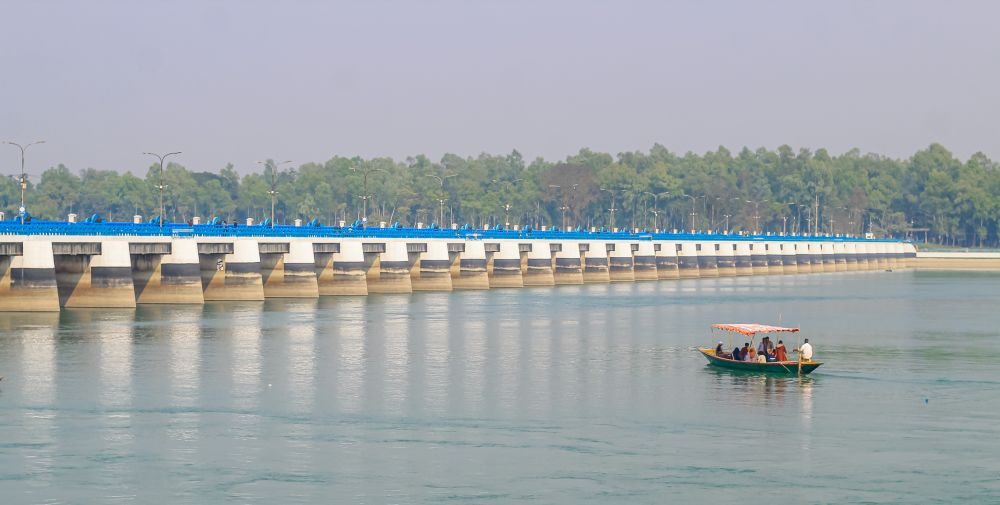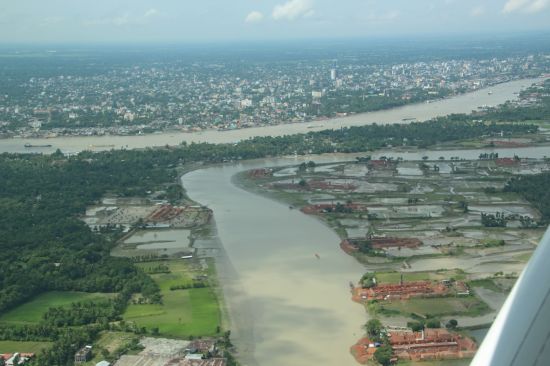In the geopolitically and geo-economically challenging world, Bangladesh must manage its way in the middle of the fraught relationship between neighbors China and India, as well as the China-US global strategic rivalry. In this context, Genevieve Donnellon-May of the University of Oxford examines Dhaka’s efforts to conclude and implement water-sharing agreements with India.
A barrage on the Teesta River: Fifty-four waterways cross the border between India and Bangladesh, with fewer than half covered by bilateral water-sharing agreements (Credit: Nadim Mahmud - Himu / Shutterstock.com)
In September, Bangladesh Prime Minister Sheikh Hasina visited India for a four-day visit. During her trip, the PM and her counterpart Narendra Modi announced that talks on a proposed bilateral Comprehensive Economic Partnership Agreement (CEPA) would begin. The two countries signed seven memoranda of understanding (MOUs) to strengthen bilateral relations. They focused on railways, space, science, legal matters and water sharing (for the Kushiyara river on their joint border). The two leaders also issued a statement welcoming the establishment of a joint technical committee on the Ganges River.
The agreements with India come at a challenging time for Bangladesh as it has struggled to weather significant economic and financial crises, food and water insecurity issues, and deal with the continued presence in the country of Rohingya refugees from Myanmar. At the same time, the impact of climate change on the economy is becoming more and more serious. The country has been devastated by flash floods, landslides, and severe erratic rainfall, causing enormous socio-economic and humanitarian damage, including the disruption of clean water supply.
The signing of the agreements also came at a time of increasing geopolitical complications in the region, as China and India’s relationship had come under further stress, especially against the backdrop of the intense China-US rivalry. Bangladesh finds itself in the middle not just of the fraught ties between its neighbors but also the global strategic competition between Beijing and Washington.
Transboundary water management has long been a contentious issue between India and Bangladesh. The absence of water-sharing agreements for the majority of transboundary rivers between them makes it difficult to pursue joint management in any effective way. There are 54 rivers that cross the India-Bangladesh border between upstream India and downstream Bangladesh. These waterways are part of the drainage system of the Ganga-Brahmaputra-Meghna (GBM) basin. A lifeline to hundreds of millions of people, the GBM basin is the third largest freshwater outlet to the world’s ocean. Only one of the rivers – the Ganges – is subject to a bilateral agreement between India and Bangladesh. For Bangladesh, the Padma (the Ganges), the Jamuna (the Brahmaputra) and the Meghna (the Barak) and their tributaries are considered essential to maintaining the country’s water and food security.
In 1972, a year after Bangladesh’s independence, the India-Bangladesh Joint Rivers Commission (JRC) was formed as a bilateral mechanism to address issues of mutual interest on transboundary rivers, only seven of which were covered by a bilateral water-sharing agreement framework. In August 2022, at the 38th ministerial-level meeting of the JRC, the two countries agreed to broaden cooperation to include eight additional rivers in the data and information program aimed at preparing a draft framework for an interim water-sharing agreement.
Kushiyara River The non-binding agreement covering the Kushiyara River is the first time that a water-sharing arrangement between the two countries had been signed since the 1996 Ganges Water Treaty (GWT). The Kushiyara River forms on the India-Bangladesh border and is a distributary of the Barak River. It is also an important source of water resources for farmers, boatmen and fishermen in both countries. The pact is expected to facilitate water projects in both south Assam (India) and Sylhet (Bangladesh) regions. According to media reports, Bangladesh plans to withdraw water from the Kushiyara to cultivate crops on land in Sylhet.
Teesta River While progress has been made with the Kushiyara River, this is not the case for the more important waterway, the Teesta. The sharing of the Teesta River, a major transboundary river, has long been a contentious issue between India and Bangladesh. The river, a tributary of the Jamuna (Brahmaputra), begins in the Teesta Kangse glacier and flows through the Indian states of Sikkim and West Bengal before entering Bangladesh. Given the rainfall deficit in West Bengal (India) and Rangpur (Bangladesh), there has been growing water demand in both countries. Further complicating matters, both countries have built diversion dams (or barrages) on the river, roughly 100 kilometers part. The Gajaldoba barrage in India irrigates approximately 920,000 hectares in West Bengal while the Teesta barrage in Bangladesh irrigates 750,000 hectares, further putting pressure on the river’s water resources.
At present, there is no binding water-sharing treaty regarding the use and allocation of Teesta River. For years, Bangladesh has sought to secure such an agreement. From 1983 to 1985, an ad hoc water-sharing agreement of the Teesta was in place. Under this agreement, India was allocated 39 percent of the flow volume, while Bangladesh would receive 36 percent. In 2011, it appeared that a water-sharing agreement for the Teesta River during the dry season (December to March) was likely, with plans to sign an agreement in September that year. Under the draft interim agreement, India would have been allocated the right to 42.5 percent of the water resources, giving Bangladesh the remaining 37.5 percent. India, however, pulled out of the deal, apparently due to strong opposition from West Bengal state’s chief minister, Mamata Banerjee, who is still in office.
Feni River Approximately 116 kilometers long, the Feni River begins in Tripura state (India) and flows southwest to the Chittagong Hill tracts in Bangladesh. At the recent JRC meeting, India requested an early signing of an interim water-sharing agreement on the Feni. Both India and Bangladesh finalized the design and location of the water intake point on the river to meet the water-drinking needs of Sabroom town in Tripura. This was agreed in accordance with the India-Bangladesh October 2019 MOU on the subject. Under this MoU, India may take 1.82 cubic feet per second of water from the river until an agreement is signed. Bangladesh, however, has expressed concern that this arrangement could affect its Muhuri-Feni Irrigation Project.
Ganges River The Ganges River, in particular the allocation and development of its water resources, has been another source of contention between India and Bangladesh. A bilateral water treaty, the Ganges Water Treaty, which recognizes Bangladesh’s rights as a lower riparian, has been in place since 1996. The deal was the result of decades of negotiation and sets out the minimum level of water flow to be shared by India and Bangladesh during the dry season (January to May). Although the treaty is set to expire in 2026, it may be renewed by mutual consent. Nonetheless, it is not without major challenges such as the growing water demand-supply gap exacerbated by agricultural activities and industrialization, as well as a declining volume in groundwater and water availability. The Ganges Water Treaty has also been criticized for having underestimated the impact of climate variability and possibly increasing upstream water abstraction.
The non-binding water-sharing pact over the Kushiyara River and the absence of one for the Teesta River must be viewed in the context of growing concern over the impact of climate change in Bangladesh as manifested by the “worst floods in a century” that the country experienced in 2022. These floods have threatened clean water supply, agriculture, infrastructure and livelihoods.
Bangladesh is often considered one of the most vulnerable economies in the world to climate change, given its disadvantageous geographic location and low-lying topography with long coastlines and floodplains occupying 80 percent of the country. Estimates suggest that by 2050, one in seven people in Bangladesh will be displaced by climate change. In 2018, a report from the US government stated that approximately 90 million people in Bangladesh (around 56 percent of the population) live in “high climate exposure areas”, while 53 million people live in “very high exposure areas”. In June 2022, researchers reported that approximately 70 million people in Bangladesh live in flood-prone areas.
Concerns about the impact of climate change in Bangladesh are made worse by the associated rise in waterborne diseases and respiratory illnesses, unmanageable rapid urbanization, weak local governance, high population density, high levels of poverty, and also reliance of livelihoods on climate-reliant sectors such as agricultural production. This has made Dhaka, the capital of Bangladesh, one of the world’s most densely populated cities, with more and more people living in flood-prone areas. Recent research found that precipitation has become more unpredictable, while rivers have been rising above dangerous levels more often. One research paper notes that if global temperatures rise by two degrees Celsius, flooding along the Brahmaputra (in Bangladesh and northeast India) is expected to rise by 24 percent. Similarly, if there is an increase by four degrees Celsius, flooding is expected to increase by over 60 percent.
While the country does have a higher per-capita gross domestic product (GDP) than India, outperforms other major South Asian countries in key socio-economic metrics and has also reduced the level of poverty in recent decades, Bangladesh is a facing a number of crucial challenges. As the Atlantic Council in Washington notes, these include an increasing trade deficit, record inflation, daily devaluation of the local currency and a severe energy crisis as well as food insecurity concerns. In addition to external factors such as the Ukraine war, domestic reasons have played a role in contributing to these crises including corruption and cronyism combined with authoritarianism under dynastic rule, the exorbitant costs of mega infrastructure vanity projects, and widespread defaults on loans
Bangladesh finds itself in the middle between China and India with both neighbors aiming to extend their competing spheres of influences in South Asia, while strengthening their regional assertiveness. Dhaka is under pressure from China which is keeping a careful eye on Bangladesh-India relations as well as Bangladesh’s bilateral relations with the US. Last year, Beijing warned Dhaka against joining the Quadrilateral Security Dialogue, known as the Quad – an informal strategic alliance comprising the US, Japan, India and Australia – labelling it a “military alliance aimed against China’s resurgence”.
Nonetheless, viewing India as a common threat, Beijing and Dhaka have formed a strategic partnership which is expected to continue to strengthen. In 2016, Dhaka officially joined the Belt and Road Initiative (BRI) and is interested in securing a free trade agreement (FTA) with Beijing. Since joining the BRI, Chinese investment in Bangladesh has reached US$38.05 billion, approximately 10 percent of the country’s GDP. In addition to significant bilateral defense cooperation, Beijing is also Dhaka’s biggest trading partner and importer, direct foreign investor, and supplier of military hardware. Given the Bangladesh’s economic woes and rampant corruption, demonstrated by its diminishing foreign exchange reserves, it needs Chinese support.
Considering that US and the Soviet Union having fought a proxy war through Pakistan and India over Bangladesh’s independence, a Sino-Indian proxy war over Bangladesh would not be out of the question. Given Chinese hydropower ambitions on the upstream of major transboundary rivers which flow into Bangladesh coupled with India’s attempts to prevent further Chinese geo-economic influence over Bangladesh, Dhaka may be able to use this situation to its advantage. In addition to reaching out to the United States to balance Sino-Indian tensions in which it may be embroiled, Dhaka may seek to secure additional agreements with both Beijing and New Delhi, including water-sharing agreements, which fall more in Dhaka’s favor. Considering the enormity of the Bangladesh’s domestic challenges, however, exacerbated by external factors such as the Ukraine-Russia war, finding just the right balance in this geopolitically and geo-economically challenging world will be difficult to achieve.
Further reading:
Check out here for more research and analysis from Asian perspectives.



